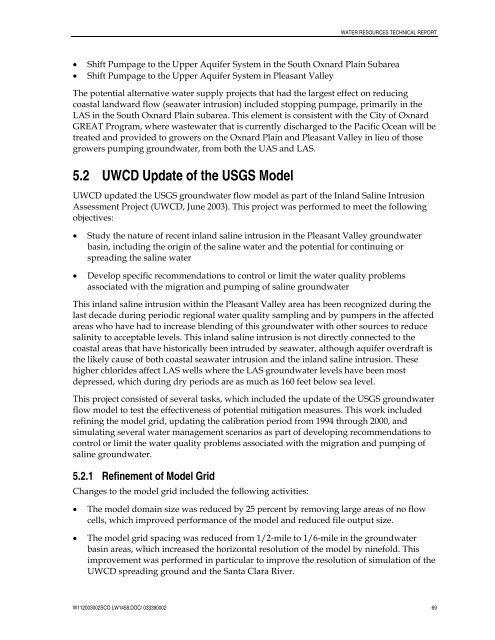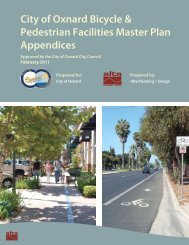View File - Development Services - City of Oxnard
View File - Development Services - City of Oxnard
View File - Development Services - City of Oxnard
You also want an ePaper? Increase the reach of your titles
YUMPU automatically turns print PDFs into web optimized ePapers that Google loves.
WATER RESOURCES TECHNICAL REPORT• Shift Pumpage to the Upper Aquifer System in the South <strong>Oxnard</strong> Plain Subarea• Shift Pumpage to the Upper Aquifer System in Pleasant ValleyThe potential alternative water supply projects that had the largest effect on reducingcoastal landward flow (seawater intrusion) included stopping pumpage, primarily in theLAS in the South <strong>Oxnard</strong> Plain subarea. This element is consistent with the <strong>City</strong> <strong>of</strong> <strong>Oxnard</strong>GREAT Program, where wastewater that is currently discharged to the Pacific Ocean will betreated and provided to growers on the <strong>Oxnard</strong> Plain and Pleasant Valley in lieu <strong>of</strong> thosegrowers pumping groundwater, from both the UAS and LAS.5.2 UWCD Update <strong>of</strong> the USGS ModelUWCD updated the USGS groundwater flow model as part <strong>of</strong> the Inland Saline IntrusionAssessment Project (UWCD, June 2003). This project was performed to meet the followingobjectives:• Study the nature <strong>of</strong> recent inland saline intrusion in the Pleasant Valley groundwaterbasin, including the origin <strong>of</strong> the saline water and the potential for continuing orspreading the saline water• Develop specific recommendations to control or limit the water quality problemsassociated with the migration and pumping <strong>of</strong> saline groundwaterThis inland saline intrusion within the Pleasant Valley area has been recognized during thelast decade during periodic regional water quality sampling and by pumpers in the affectedareas who have had to increase blending <strong>of</strong> this groundwater with other sources to reducesalinity to acceptable levels. This inland saline intrusion is not directly connected to thecoastal areas that have historically been intruded by seawater, although aquifer overdraft isthe likely cause <strong>of</strong> both coastal seawater intrusion and the inland saline intrusion. Thesehigher chlorides affect LAS wells where the LAS groundwater levels have been mostdepressed, which during dry periods are as much as 160 feet below sea level.This project consisted <strong>of</strong> several tasks, which included the update <strong>of</strong> the USGS groundwaterflow model to test the effectiveness <strong>of</strong> potential mitigation measures. This work includedrefining the model grid, updating the calibration period from 1994 through 2000, andsimulating several water management scenarios as part <strong>of</strong> developing recommendations tocontrol or limit the water quality problems associated with the migration and pumping <strong>of</strong>saline groundwater.5.2.1 Refinement <strong>of</strong> Model GridChanges to the model grid included the following activities:• The model domain size was reduced by 25 percent by removing large areas <strong>of</strong> no flowcells, which improved performance <strong>of</strong> the model and reduced file output size.• The model grid spacing was reduced from 1/2-mile to 1/6-mile in the groundwaterbasin areas, which increased the horizontal resolution <strong>of</strong> the model by ninefold. Thisimprovement was performed in particular to improve the resolution <strong>of</strong> simulation <strong>of</strong> theUWCD spreading ground and the Santa Clara River.W112003002SCO LW1458.DOC/ 033390002 69
















